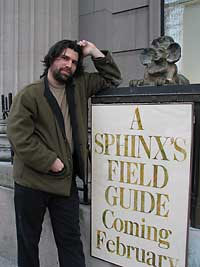Questionable Creature
The sphinx that´s become a citizen of Northampton,
and the artist who made him.
by Sarah Buttenwieser — February 10, 2005 — Valley Advocate
Michael Kuch’s Sphinx in Bloom, a bronze sculpture of a sphinx with a floral headdress for its mane, has been perched atop an inactive night deposit box in front of Richard Michelson’s former bank turned gallery for about three years now. It began its life, however, as just another freestanding sculpture for sale.
“When Michael first brought the sphinx in,” says Michelson, “it was displayed in the front of the gallery, and after a while, when I faced putting it in temporary storage to make room for a big show, I realized how much I hated putting it away. I love the sculpture. It dawned on me that the sphinx was the perfect sculpture for that beautiful spot in front of the gallery.”
Kuch, says Michelson, liked the idea and the pair enlisted local furniture designer Richard Hardie to devise a way to secure the sculpture to its perch.
“At first, a lot of people inquired about the sculpture and Michael’s work,” says Michelson. “I do still get inquiries about the sphinx, but not as many as when it was first installed there.
“Now, it’s part of the landscape. Most of the locals know who did the sculpture. Still, when I walk outside my building during the summer, I often see people gathered around the sculpture talking about it, engaged with it. The man who plays guitar in front during the summer hangs his hat on it. People stop by and thank me for having the sculpture out there, saying they love the sculpture and feel it enhances the beauty of the building.”
Kuch, who found his way to the Valley in the early ’80s when he was a student at Hampshire College, stayed in large part because of his relationship to the late artist, Leonard Baskin. After he studied with Baskin at Hampshire, the teacher acted as his mentor, and then his employer. Kuch became a master printer, printing books for Baskin’s fine art press, the Gehenna Press, over the span of a dozen years.
Kuch established his own Double Elephant Press in 1994, and over the past decade its books — which are in such collections as Yale’s Beinecke Library, Smith College’s rare book collection and the Library of Congress — have made a name for him in the world of fine art book publishing.
Fine art books like the ones by Double Elephant consist of original work, generally etchings or woodcuts. The books are often supplemented with text of some sort; they have small print runs; they’re bound by premiere bookbinders, who use high-quality materials (paper imported from Italy, for example); and the deluxe editions can sell for as much as seven thousand dollars a copy.
Among Double Elephant’s books are Séance for A Minyan, in collaboration with the late Poet Laureate Anthony Hecht. In 1999, Kuch published Apocalypse Clocks, a meditation on the timeless and the ephemeral pegged to the millennium. Kuch also printed Lemons Descending, a book that included the eponymous musical recording of composer Luna Pearl Woolf and her husband, world-class cellist Matt Haimovitz.
It was around the time Kuch was working on Apocalypse Clocks that he finished Sphinx in Bloom, which is also, he says, concerned with time, with the contrast between the eternal and the ephemeral. “The sphinx is an iconic image,” he says, “resting in the sands of time, while flowers open and close in a matter of days… There’s something tantalizing about how we see time. Our sense of it is evocative and even provocative.”
Double Elephant’s eighth book, A Sphinx´s Field Guide to Questionable Answers, is a return to the Sphinx and its mysteries. It’s premiering on Feb 11th, just a pane of glass away from where its namesake rests, and boasts the press’ largest run to date: 150 copies.
In conjunction with the book, Kuch has a gallery show, A Sphinx´s Field Guide, opening this week and continuing into March. Pages from the book — chiraroscuro woodcuts and wood type text — are featured on the walls of the first exhibition room. In the next space, watercolors inspired by the sphinx’s adventures hang.
Of the appeal of having one of his sculptures be part of Northampton’s streetscape, Kuch says, “I always wish for more public sculpture. I love Philadelphia for that reason. I love the idea that public sculpture gives place a presence, that someone can say, ‘Meet me at the Sphinx.'”
He adds, of his own sphinx, “I like how it seems to be watching the people passing by, it being the viewer rather than the passersby viewing it. … I notice the sculpture each and every time I pass by. One can’t be an artist without letting go of one’s work and for me, the sphinx is kind of like a pet I let go of; every time I go by, I notice it noticing me.”
A Sphinx’s Field Guide opens on Feb. 11 with a reception from 5-7 p.m. at R. Michelson Galleries, 132 Main St., Northampton, 586-3964, www.rmichelson.com.